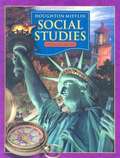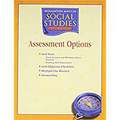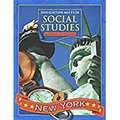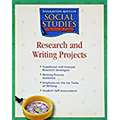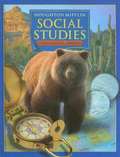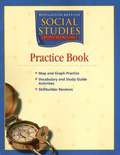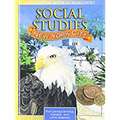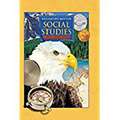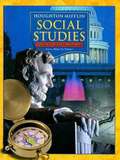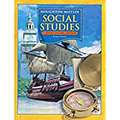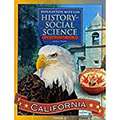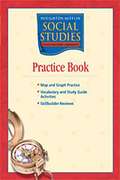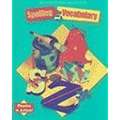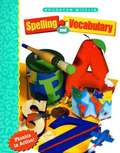- Table View
- List View
Houghton Mifflin Social Studies (Tennessee Edition)
by Herman J. Viola Sarah Witham Bednarz Mark C. Schug Charles S. White Cheryl Jennings Carlos E. CortésTo learn everything about Tennessee you have to read this book. You will find details about its people, regions, cultures, geography, government and history.
Houghton Mifflin Social Studies 5: United States Civil War to Today (Tennessee Edition)
by Herman J. Viola Sarah Witham Bednarz Mark C. Schug Charles S. White Cheryl Jennings Carlos E. CortesThis book contains topics on Our Land and Its Government, The Civil War, Transforming a Nation, The Early Twentieth Century, Modern America and Linking to the Present.
Houghton Mifflin Social Studies Student Edition Supplement Grade 3: World Communities
by Houghton MifflinSocial Studies Student Edition Supplement Grade 3 World Communities
Houghton Mifflin Social Studies Tennessee: United States History (Level #4)
by Herman J. Viola Sarah Witham Bednarz Mark C. Schug Charles S. White Cheryl Jennings Carlos E. CortésThis book covers the culture, economics, geography, governance & civics, history, individuals, groups and interactions of Tennessee.
Houghton Mifflin Social Studies: Canada and Latin America
by Houghton MifflinHoughton Mifflin Social Studies: Canada and Latin America builds on and reinforces historical and political content about the United States included in the grade 4 social studies program.
Houghton Mifflin Social Studies: Communities
by Herman J. Viola Sarah Witham Bednarz Mark C. Schug Charles S. White Maryellen Vogt Cheryl Jennings Dolores Beltran Carlos E. CortesTextbook on how communities function.
Houghton Mifflin Social Studies: Communities (Grade 2, Tennessee Edition)
by Herman J. Viola Sarah Witham Bednarz Mark C. Schug Charles S. White Cheryl Jennings Carlos E. CortésLearn about Tennessee, its people, economics, geography and history.
Houghton Mifflin Social Studies: Illinois Studies
by Dr Charles S. White Senior Author. Dr Cheryl Jennings. Dr Sarah Witham Bednarz. Dr Mark C. Schug. Dr Carlos E. Cortés.Social studies textbook
Houghton Mifflin Social Studies: Maryland Studies
by The Editors at the Houghton MifflinThis text presents an approach to learning and practising key social studies aspects, like meeting state's standards, reading maps and graphs as well as building citizenship skills for life etc.
Houghton Mifflin Social Studies: My World, Assessment Options
by Houghton Mifflin CompanyNIMAC-sourced textbook
Houghton Mifflin Social Studies: Neighborhoods, Assessment Options
by Houghton Mifflin CompanyNIMAC-sourced textbook
Houghton Mifflin Social Studies: New York Studies
by Herman J. ViolaSocial studies textbook about New York.
Houghton Mifflin Social Studies: School and Family, Research and Writing Projects
by Houghton Mifflin CompanyNIMAC-sourced textbook
Houghton Mifflin Social Studies: States and Regions
by Herman J. Viola Cheryl Jennings Carlos E. Cortes Sarah WithamSocial studies textbook about the various states and regions of the United States.
Houghton Mifflin Social Studies: States and Regions Practice Book
by Houghton MifflinThis practice book contains unit lessons on: The Land of the United States, The East, The South, The Midwest, The West, and Connections to Our World.
Houghton Mifflin Social Studies: The United States, Canada, and Latin America (New York City Edition)
by Herman J. Viola Sarah Witham Bednarz Mark C. Schug Charles S. White Cheryl Jennings Carlos E. CortésThe United States, Canada, and Latin America, inter alia, contains Interactive lesson summaries of Geography, Early Civilizations in the Americas, European Exploration, Creating a New Nation, A Time of Change, Growth and Expansion, Geography and Early People, Spanish and Portuguese Colonies, Modern Latin America, Geography and First Peoples, Colonial Canada, Modern Canada, Government in the Americas, and The Western Hemisphere Today.
Houghton Mifflin Social Studies: United States History (Level #5)
by Herman J. Viola Maryellen Vogt Dolores Beltran Sarah BednarzThis book includes many features to help you be a successful reader which include comprehension support, reading skills, reading strategies and vocabulary support.
Houghton Mifflin Social Studies: United States History, Civil War to Today
by Herman J. Viola Sarah Witham Bednarz Mark C. Schug Charles S. White Cheryl Jennings Carlos E. CortésHistory textbook about the past 150 years in the USA.
Houghton Mifflin Social Studies: United States History, Early Years
by Herman J. Viola Sarah Witham Bednarz Mark C. Schug Charles S. White Cheryl Jennings Carlos E. CortesThis Social Studies book contains topics on: Our Land and First People, Exploration and Settlement, The English Colonies, The American Revolution, The New Nation, The Civil War, and Linking to Today.
Houghton Mifflin Social Studies: United States History, Early Years (5th Grade Louisiana Edition)
by Herman J. Viola Sarah Witham Bednarz Carlos E. Cortés [et al.]Houghton Mifflin Social Studies Early Years, covers the early peoples history, their lives, culture, their activities and the events that took place.
Houghton Mifflin Social Studies: United States History, Early Years (California Edition)
by Herman J. Viola Sarah Witham Bednarz Mark C. Schug Charles S. White Cheryl Jennings Carlos E. CortésThe history of United States is told in this textbook through the research of historians, through quotations, letters, songs, and voices from the past, and through images, fine art, and data--a rich resource for learning.
Houghton Mifflin Social Studies: World Cultures and Geography, Practice Book
by Houghton MifflinNIMAC-sourced textbook
Houghton Mifflin Spelling and Vocabulary (Grade #1)
by Shane TempletonSpelling and vocabulary for elementary school students.
Houghton Mifflin Spelling and Vocabulary (Grade #1)
by Shane TempletonSpelling and vocabulary for elementary school students.

